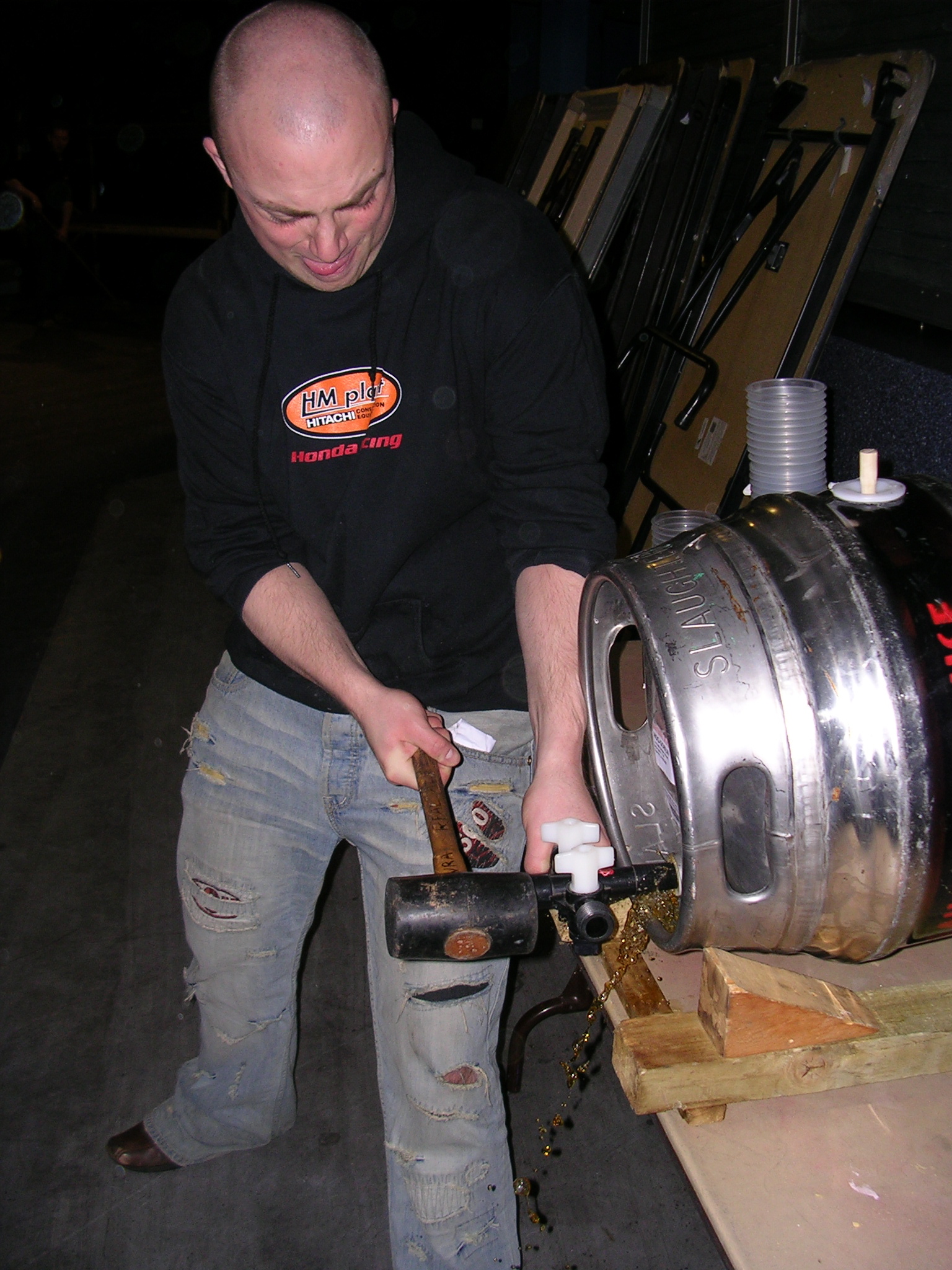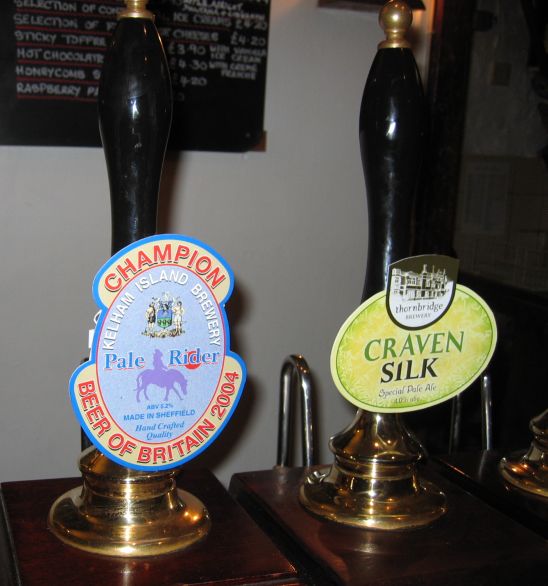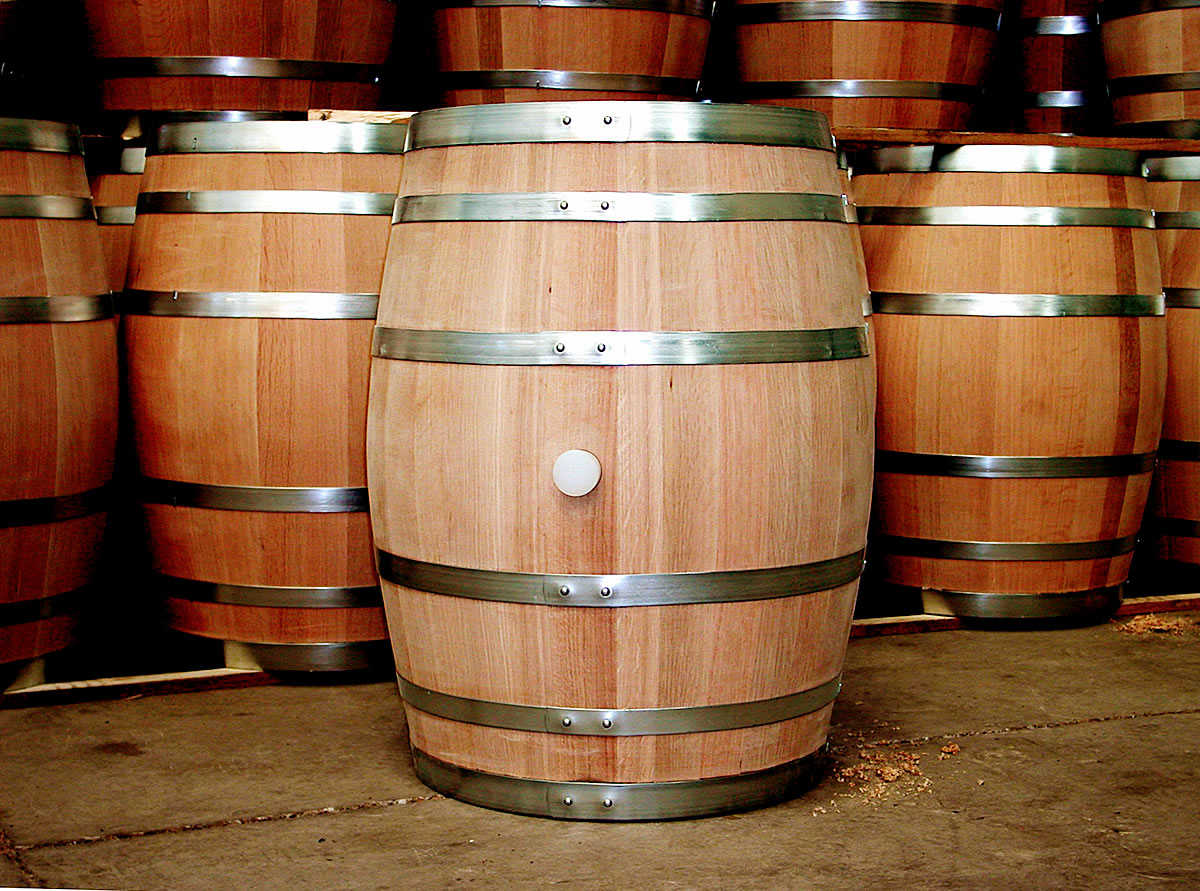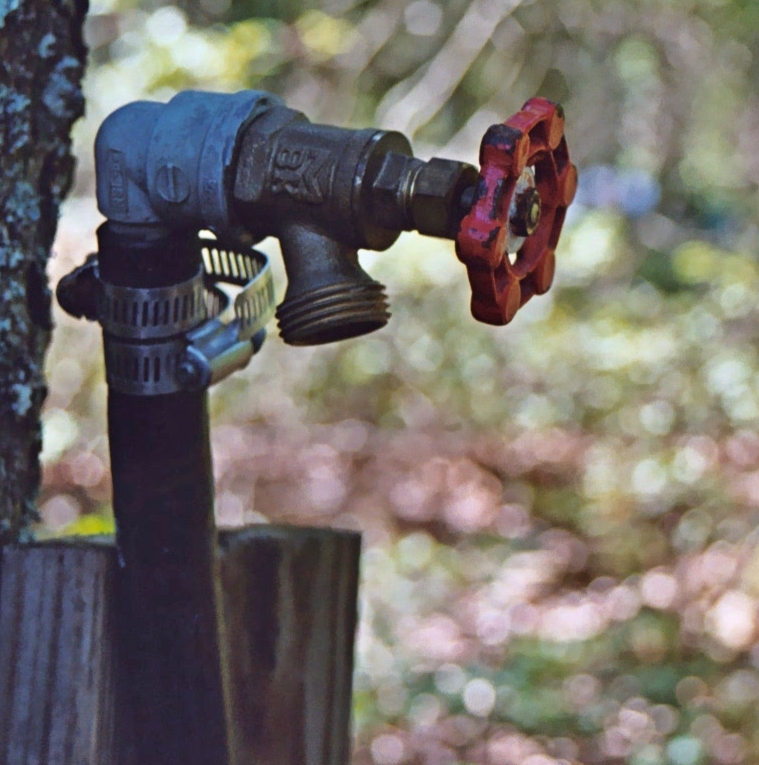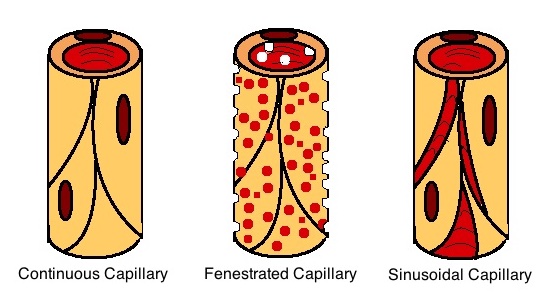|
Spile
A spile (sometimes called a "cask peg") is a wooden or metal peg used to control the flow of air into, and carbon dioxide out of, a cask of ale or wine. Spiles can also be used to broach liquids (like maple syrup) from a tree. Ale use Cask ale is dispensed without the addition of externally supplied gas. Properly conditioned cask ale will have enough dissolved carbon dioxide (produced by yeast) to have bubbles. In fact, the yeast can produce more carbon dioxide than is required, and it is for this reason that the cask is vented through the hole in the shive. The cask is sealed when it is first connected to a beer engine. It has a keystone (where the beer tap will be driven in) and a shive (through which it was filled). Once it has been laid down for dispensing, a venting punch is used to pierce the shive, which is either partially pre-drilled or has a hardwood tutt sealing the completely drilled hole. This breaks the seal, and the tap can then be driven into the keystone. To al ... [...More Info...] [...Related Items...] OR: [Wikipedia] [Google] [Baidu] [Amazon] |
Shive
{{Refimprove, date=November 2009 A shive is a wooden or plastic fitting used in ale casks. It is found on the curved side of the cask, arranged so that when the cask is on its side and the keystone is at the lowest part of the rim, the shive will be the highest point of the cask. The hole in that part of the cask is used for two purposes. Firstly, it is used for cleaning out and then refilling the cask, which requires a large hole. Once the cask arrives at its destination, the hole is used to control the amount of carbon dioxide present in the container, which requires a small hole. The shive is effectively an adaptor that reconciles these conflicting requirements. It is a wooden disk, larger than a keystone, that fits in the hole in the cask and has a smaller hole in its centre. For washing and filling, the old shive is removed using a chisel or a special tool, revealing a hole around 3 inches (7.5 cm) across. Once the cask has been filled and fined, a new shive is hammere ... [...More Info...] [...Related Items...] OR: [Wikipedia] [Google] [Baidu] [Amazon] |
Keystone (cask)
A keystone is a small wooden or plastic fitting used in cask ale, ale Barrel (storage), casks. For some years wooden casks have been effectively obsolete, with the majority now being aluminium or stainless steel, and a few sturdy plastic ones beginning to appear. Nevertheless, the standard tap (valve), tap is still designed to be hammered into yielding material, punching a hole as it goes. All modern casks, even the few wooden ones still in use, use a replaceable keystone to accept the tap. Background The bung-hole of the cask is on one of the circular faces, near the rim. When the cask is in service, it is laid on its side with the bunghole at the lowest point on the circumference. The keystone is a small thick wooden or plastic disk inserted into the bunghole which completely seals the cask until it is needed. The center of the keystone is deliberately weakened, this area may be marked or unmarked and is called the tut. In the plastic variety it is much thinner than the surroundin ... [...More Info...] [...Related Items...] OR: [Wikipedia] [Google] [Baidu] [Amazon] |
Beer Engine
A beer engine is a device for pumping beer from a cask, usually located in a pub's cellar. The beer engine was invented by John Lofting, a Dutch inventor, merchant and manufacturer who moved from Amsterdam to London in about 1688 and patented a number of inventions including a fire hose and engine for extinguishing fires and a thimble knurling machine. ''The London Gazette'' of 17 March 1691 stated "the patentee hath also projected a very useful engine for starting of beers and other liquors which will deliver from 20 to 30 barrels an hour which are completely fixed with brass joints and screws at reasonable rates." The locksmith and hydraulic engineer Joseph Bramah developed beer pumping further in 1797. The beer engine is normally manually operated, although electrically powered and gas powered pumps are occasionally used; when manually powered, the term ''handpump'' is often used to refer to both the pump and the associated handle. The beer engine is normally located below ... [...More Info...] [...Related Items...] OR: [Wikipedia] [Google] [Baidu] [Amazon] |
Cask
A barrel or cask is a hollow cylindrical container with a bulging center, longer than it is wide. They are traditionally made of wooden staves and bound by wooden or metal hoops. The word vat is often used for large containers for liquids, usually alcoholic beverages; a small barrel or cask is known as a keg. Barrels have a variety of uses, including storage of liquids such as water, oil, and alcohol. They are also employed to hold maturing beverages such as wine, cognac, armagnac, sherry, port, whiskey, beer, arrack, and sake. Other commodities once stored in wooden casks include gunpowder, meat, fish, paint, honey, nails, and tallow. Modern wooden barrels for wine-making are made of English oak (''Quercus robur''), white oak (''Quercus petraea''), American white oak (''Quercus alba''), more exotic is mizunara oak ('' Quercus crispula''), and recently Oregon oak ('' Quercus garryana'') has been used. Someone who makes traditional wooden barrels is called a coope ... [...More Info...] [...Related Items...] OR: [Wikipedia] [Google] [Baidu] [Amazon] |
Maple Syrup
Maple syrup is a sweet syrup made from the sap of maple trees. In cold climates, these trees store starch in their trunks and roots before winter; the starch is then converted to sugar that rises in the sap in late winter and early spring. Maple trees are tapped by drilling holes into their trunks and collecting the sap, which is processed by heating to evaporate much of the water, leaving the concentrated syrup. Maple syrup was first made by the Indigenous peoples of North America, Indigenous peoples of Northeastern North America. The practice was adopted by European settlers, who gradually changed production methods. Technological improvements in the 1970s further refined syrup processing. Almost all of the world's maple syrup is produced in Canada and the United States. Maple syrup is graded based on its colour and taste. Sucrose is the most prevalent sugar in maple syrup. In Canada, syrups must be made exclusively from maple sap to qualify as maple syrup and must also be ... [...More Info...] [...Related Items...] OR: [Wikipedia] [Google] [Baidu] [Amazon] |
Lwów - Barrels
Lviv ( or ; ; ; see #Names and symbols, below for other names) is the largest city in western Ukraine, as well as the List of cities in Ukraine, fifth-largest city in Ukraine, with a population of It serves as the administrative centre of Lviv Oblast and Lviv Raion, and is one of the main Ukrainian culture, cultural centres of Ukraine. Lviv also hosts the administration of Lviv urban hromada. It was named after Leo I of Galicia, the eldest son of Daniel of Galicia, Daniel, King of Ruthenia. Lviv (then Lwów) emerged as the centre of the historical regions of Red Ruthenia and Galicia (Eastern Europe), Galicia in the 14th century, superseding Halych, Chełm, Belz, and Przemyśl. It was the capital of the Kingdom of Galicia–Volhynia from 1272 to 1349, when it went to King Casimir III the Great of Kingdom of Poland, Poland in a Galicia–Volhynia Wars, war of succession. In 1356, Casimir the Great granted it town rights. From 1434, it was the regional capital of the Ruthenian ... [...More Info...] [...Related Items...] OR: [Wikipedia] [Google] [Baidu] [Amazon] |
Spigot
A tap (also spigot or faucet: see usage variations) is a valve controlling the release of a fluid. Nomenclature United Kingdom * Tap is used in the United Kingdom and most of the Commonwealth for any everyday type of valve, particularly the fittings that control water supply to bathtubs and sinks. United States * Faucet is the most common term in the US, similar in use to "tap" in British English, e.g. "water faucet" (although the term "tap" is also used in the US). * Spigot is used by professionals in the trade (such as plumbers), and typically refers to an outdoor fixture. * Silcock (and sillcock), same as "spigot", referring to a "cock" (as in stopcock and petcock) that penetrates a foundation sill. * Bib, bibcock, or hose bib, usually a freeze-resistant version of a "spigot". * Wall hydrant, same as "hose bib". * Tap generally refers to a keg or barrel tap, though also commonly refers to a faucet that supplies either hot or cold water and not both. It also appears a ... [...More Info...] [...Related Items...] OR: [Wikipedia] [Google] [Baidu] [Amazon] |
Indian Harbour, Nova Scotia
Indian Harbour is a small fishing community of the Halifax Regional Municipality in the Provinces and territories of Canada, Canadian province of Nova Scotia on the Chebucto Peninsula. It is located between the communities of Peggy's Cove, Nova Scotia, Peggy's Cove and Hackett's Cove, Nova Scotia, Hackett's Cove. History Indian Harbour was founded in the early 18th century. The first recorded person to live in Indian Harbour was John Ormsby in 1784. The first and the oldest house in Indian Harbour is still standing today at the age of over 250 years. Indian Harbour is located next to the popular tourist destination Peggys Cove, Nova Scotia, Peggy's Cove and its famous lighthouse. There is also a lighthouse in Indian Harbour, located at the end of Paddy's Head Peninsula. The lighthouse was built in 1901 and staffed until 1945, when power was introduced to the area. Indian Harbour's roads were dirt and had to be up kept by the locals until 1955 when Route 333 was widened and ... [...More Info...] [...Related Items...] OR: [Wikipedia] [Google] [Baidu] [Amazon] |
Catching Fire
''Catching Fire'' is a 2009 dystopian young adult fiction novel by the American novelist Suzanne Collins, the second book in ''The Hunger Games'' series. As the sequel to the 2008 bestseller ''The Hunger Games'', it continues the story of a now 17 year old Katniss Everdeen and the post-apocalyptic nation of Panem. Following the events of the previous novel, a rebellion against the oppressive Capitol has begun, and Katniss and fellow tribute Peeta Mellark are forced to return to the arena in a special edition of the Hunger Games. The book was first published on September 1, 2009, by Scholastic, in hardcover, and was later released in ebook and audiobook format. ''Catching Fire'' received mostly positive reviews, with reviewers praising Collins' prose, the book's ending, and the development of Katniss's character. According to critics, major themes of the novel include survival, authoritarianism, rebellion and interdependence versus independence. The book has sold more tha ... [...More Info...] [...Related Items...] OR: [Wikipedia] [Google] [Baidu] [Amazon] |
Beer Tap
A beer tap is a valve, specifically a tap, for controlling the release of beer. While other kinds of tap may be called ''faucet'', ''valve'' or ''spigot'', the use of ''tap'' for beer is almost universal. The word was originally coined for the wooden valve in traditional barrels. Beer served from a tap is largely known as draught beer, though beer served from a cask is more commonly called cask ale, while beer from a keg may specifically be called keg beer. Beer taps can be also used to serve similar drinks like cider or long drinks. There are many different types and styles of beer or keg taps. Etymology Originally the word referred to a solid wood stopper used to plug the hole in a barrel, so as to contain the contents. The shape was identical to a taproot, from which the name derived. The word was originally coined for the wooden valve in traditional barrels. Usage Pressure-dispense bar tap Beer supplied in kegs is served with the aid of external pressure from a cylinder o ... [...More Info...] [...Related Items...] OR: [Wikipedia] [Google] [Baidu] [Amazon] |
Capillary
A capillary is a small blood vessel, from 5 to 10 micrometres in diameter, and is part of the microcirculation system. Capillaries are microvessels and the smallest blood vessels in the body. They are composed of only the tunica intima (the innermost layer of an artery or vein), consisting of a thin wall of simple squamous endothelial cells. They are the site of the exchange of many substances from the surrounding interstitial fluid, and they convey blood from the smallest branches of the arteries (arterioles) to those of the veins (venules). Other substances which cross capillaries include water, oxygen, carbon dioxide, urea, glucose, uric acid, lactic acid and creatinine. Lymph capillaries connect with larger lymph vessels to drain lymphatic fluid collected in microcirculation. Etymology ''Capillary'' comes from the Latin word , meaning "of or resembling hair", with use in English beginning in the mid-17th century. The meaning stems from the tiny, hairlike diameter of a capi ... [...More Info...] [...Related Items...] OR: [Wikipedia] [Google] [Baidu] [Amazon] |
